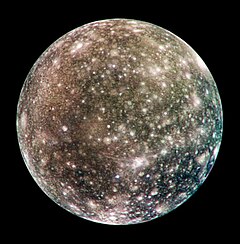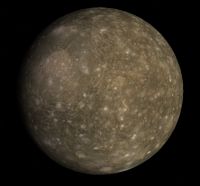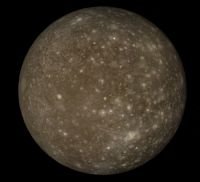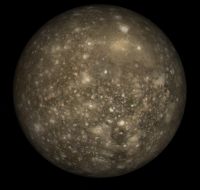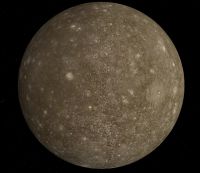Difference between revisions of "Callisto"
(Added link, image, content for Voyager1Jupiter.zip.) |
(Added category.) |
||
| Line 85: | Line 85: | ||
[[Category:Articles]] | [[Category:Articles]] | ||
[[Category:Celestial bodies]] | [[Category:Celestial bodies]] | ||
| + | [[Category:Solar System]] | ||
[[Category:Natural satellites]] | [[Category:Natural satellites]] | ||
[[Category:Satellites of Jupiter]] | [[Category:Satellites of Jupiter]] | ||
Revision as of 03:23, 12 September 2024
 | This natural satellite related article is a stub. You can help Orbiterwiki by expanding it.
Callisto is the outermost of Jupiter's four Galilean Moons, and has been a part of Orbiter since it was added in Orbiter 2002. Callisto is the second largest moon of Jupiter just behind Ganymede, and is the third largest moon after Ganymede and Titan. And Callisto is just about the same size as the planet Mercury. Callisto was discovered independently by w:Simon Marius and w:Galileo Galilei in 1610, Marius having seen it slightly before Galileo, and the name given by Marius is the one that we use today. Callisto in OrbiterCallisto joined Orbiter with the release of Orbiter 2002. At that time its orbit was governed by the Callisto.cfg file, then governed by Vsop87.dll file at the release of Orbiter 2005. The orbit of Callisto is not locked into an orbital resonance with Io, Europa, and Ganymede, which are in a 1:2:4 resonance. It revolves about 1.88×106 kilometers from Jupiter, eccentricity of 0.0074, and an inclination of about 0.25°. The moon has a mass of 1.08×1023 kilograms and a radius of about 2.4×106 km. Orbiter versions and add-ons for Callisto.
| ||||||||||||||||||||||||||||||||||||||||||||||||||||||||||
